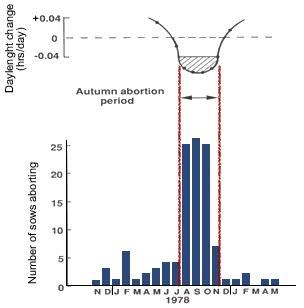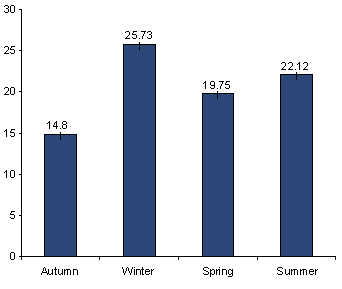Primary infection of the reproductive tract and of the fetuses is likely to precipitate abortion. Other causes of abortions include more nebulous factors such as environmental or nutritional stress, seasonal failure of the hormonal maintenance of pregnancy, systemic disease in the sow, exposure to toxic agents and chromosomal abnormalities of the fetuses.

It must be remembered that the wild European pig is anoestrous from July to December, with oestrus cycles re-commencing in late winter. We expect the domesticated pig to breed naturally throughout the year but, in the autumn, blood levels of progesterone (the hormone of pregnancy) decline significantly with the increasing rate of the decline in day-length until the winter solstice is reached. During this time, progesterone levels also show much greater variation from farm to farm and, as levels fall variably throughout the pig population, there will inevitably be an increase in the number of sporadic failures of pregnancy, which vary in number from farm to farm. Seasonal abortion is influenced by the nutritional status of the individual sow, climatic conditions and the intensity and duration of the photoperiod. Artificial lighting can help offset seasonal failures, but it must be powerful enough to stimulate the pineal gland. In the author's opinion, focused spotlighting is better than background fluorescent lighting.

Seasonal changes in blood progesterone (Wrathall et al, 1986)
Infectious causes of abortion include the following:
• ViralNon-infectious cause of abortion, other than seasonality, might include:
African Swine Fever – striking clinical picture• Bacterial
Aujeszky’s Disease – relatively common in unprotected herds
Classical Swine Fever – striking clinical picture
Encephalomyocarditis virus – high mortality in piglets
Enterovirus (SMEDI) – abortion storms in early to mid-term pregnancy
Porcine Respiratory and Reproductive Syndrome Virus (PRRS)
Primarily a respiratory disease in Europe. Some late abortions, or early farrowings, and respiratory disease particularly in weaners
Porcine Parvovirus – primarily infertility and mummification at various stages of pregnancy. Occasional abortion in early to mid-pregnancy
Swine Influenza – especially with PRRS – respiratory disease with fever. Abortion any time
Porcine circovirus Type 2 - possibly a cause of abortion through fetal infection
Actinobacillus pleuropneumoniae – in a primary outbreak. Striking respiratory disease. Abortion in surviving sows with high fever
Brucella suis – abortion storms at any stage with clinical illness
Swine Erysipelas – abortion as a result of high fever at any time. Diagnosis often made on clinical appearance
Leptospirosis – particularly pomona, tarassovi, and bratislava. Abortion and illness late gestation. Often whole litters stillborn.
Possibly icterus and meningitis
Uterine infection caused by a wide variety of bacteria. Usually not a herd problem, more individual.
• Feed relatedHaving established that the incidence of abortion is above expected levels and that the pattern suggests a specific event, the clinical history can suggest a cause. In an investigation of abortion, the primary aim is to distinguish between infectious and non-infectious causes. Examination of the aborted fetuses will help distinguish between maternal and fetal infection. Fetuses all of the same size will indicate maternal failure and fetuses of different sizes, possibly with pathological changes, will indicate fetal infection.
Mycotoxins – possibly aflatoxin, fumonisin, vomitoxin, and zearalenone. Usually other clinical signs more important than abortion. Mycotoxicosis tends to be self-limiting because refusal of contaminated feed is common.• Toxic
Ergotamine – sometimes causes abortion. Evidence of Claviceps infection of whole grain.
Overfeeding or starvation.
Carbon dioxide or carbon monoxide poisoning.• Climatic - heat stress through excessively high ambient temperature and sunburn through release of inflammatory cytokines and prostaglandins.
Organophosphates.
• Environmental stress and aggression, which raise blood cortisol levels.

Environmental stress, trauma, infections causing fever in the sow, uro-genital infection and gross nutritional deficiencies are some of the causes of maternal failure. In these circumstances, aborted foetuses appear to be pathologically unremarkable.
Infectious diseases that disrupt reproductive function specifically tend to produce clinical signs in the sow, in aborted foetuses and in new-born piglets.
The most appropriate samples for laboratory investigation are:
• Air-dried blood smears fixed in methanol from sows and neo-nates
• Air-dried scrape smears of oviducts from cull sows
• Aborted foetuses
• Tissues from aborted foetuses – spleen, liver, lungs
• Swabs of fetal peritoneal or pleural fluid
• Tissues from diseased neo-nates – cardiac muscle, spleen, lymph nodes, liver, lung and brain as for aborted foetuses
• Serum from sows, preferably paired samples 3 weeks apart
• Samples of feed and of feed ingredients




